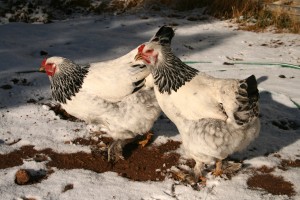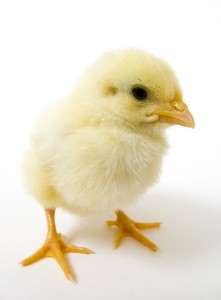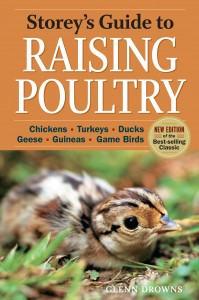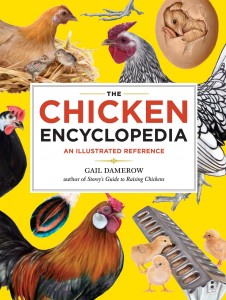When can I expect my chicks to arrive, and what do I do if there is a problem?
When placing an order with us, we will give you the expected ship date. This will be the day the chicks are hatched and actually sent out. We then allow 2 to 3 days for arrival. They are shipped priority mail through the USPS. Your phone number appears on the label on the box, so your local post office will call you when the chicks arrive for you to pick up. We guarantee live delivery, but need to be notified of any problem or loss within 48 hours. If any loss, we need to know the live count since a few extras are usually included in your order. If notified within this time frame, we can issue you a credit or a replacement order if there are enough chicks for a reshipment. When you place your order, we let you know the ship date at that time. You’ll want to put this date on your calendar. You are usually mailed or emailed a confirmation when you place your order, which is your reminder of the ship date.
All posts by mriley
A better understanding of the NPIP.
Wondering what NPIP is and what it stands for? It stands for National Poultry Improvement Plan.
If you receive poultry from Welp Hatchery, our INVOICE or PACKING SLIP can be used as an NPIP form for fairs.
NPIP Information and Requirements in Iowa
EXHIBITION / FAIR TESTING
There has been some confusion about which birds need to be tested before entering an exhibit or fair. The regulation states:
“All poultry exhibited must come from U.S. Pullorum-Typhoid clean or equivalent flocks, or have had a negative Pullorum-Typhoid test within 90 days of public exhibition and the test must have been performed by an authorized tester.”
A bird purchased and taken home from a hatchery, U.S. Pullorum-Typhoid (PT) clean or equivalent NPIP flock does not retain this “U.S. Pullorum-Typhoid clean or equivalent flock” status at the new owner’s or exhibitor’s home, unless the new owner’s or exhibitor’s flock is a PT clean flock.
In other words, just because you purchase a bird from a PT clean flock, it does not remain PT clean once you take it to your home and your flock is not proven to be PT clean also.
The National Poultry Improvement Plan (NPIP) is a cooperative Federal-State-Industry program developed for controlling certain poultry diseases. NPIP consists of a variety of programs intended to prevent and control egg-transmitted, hatchery disseminated poultry diseases. NPIP identifies states, flocks, hatcheries, and dealers that meet certain disease control standards specified in the various programs. As a result, customers can buy poultry that has tested free of certain diseases or conditions. Being a member of NPIP allows greater ease in moving hatching eggs/live birds within the state, across state lines, and into other countries. In fact, most countries will not accept hatching eggs/live birds unless they can be shown to be a NPIP participant.
The Iowa Poultry Association oversees Iowa’s involvement in NPIP, regulates the importation and exportation of birds, issues permits for breeder flocks, along with administering laws and rules regarding poultry in Iowa.
Source: http://iowapoultry.com/
By Ann Phelps.
5 tips for getting hens to lay in nest boxes.
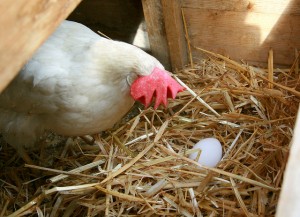
https://www.flickr.com/photos/72284410@N08/
Do your hens lay their eggs everywhere but the nest boxes? Here are a few tips to encourage them to lay eggs in the nest boxes.
• Do you have enough nest boxes: 1 box for every 4 to 5 hens is the minimum for hens to feel comfortable laying in them.
• Are your nests appealing: Make sure the nests are in a dark, quiet place in the coop. Boxes should be a few inches off the floor.
• Train them with a “nest egg”: You can purchase a fake ceramic or wood egg from a farm supply store or online. You can even use a golf ball if needed. When your chicks get ready to lay, by placing the “nest egg” in the nests, this gives them the idea that this is the place to lay.
• Keep them confined until mid-morning: Most hens lay early in the morning, so by keeping them in the coop, this will maximize the chances that they’ll lay in the nest boxes instead of finding a place outside of the coop.
• Make nests soft and comfy: If the wood shavings get depleted in the boxes, the hens tend to avoid them. Keep shavings or straw nice and fluffy to encourage laying in the boxes.
Michelle Coleman
Reference:
About.com
Preparing for winter
Check out these tips for keeping your chickens warm in the coming cold months.
Tip # 1
Raise cold –hardy breeds that are suited to the temperature in your climate.
Breeds with smaller, more compact combs, such as a pea or rose combs, fare better in cold and are less prone to frostbite on their combs.
Great examples of cold-hardy breed with pea or rose combs include Ameraucanas, Buckeyes and Wyandottes.
Tip # 2
Proper coop insulation and ventilation in any poultry housing set-up is absolute for fighting frostbite and for combating deadly moisture that could contribute to a host of other ailments and diseases.
Tip # 3
Many breeds can make it through winter without supplemental heat. But for breeds that don’t always fare well in extreme cold, it may be necessary to add supplemental heat to the coop to combat moisture, cold or a combination of the two.
Properly and professionally set up the supplemental heat in the coop.
Use poultry-safe heat lamps with guards. Only heat the coop to a reasonable, winter temperature for your area to take the edge off; it should not feel warm to you.
Reduce supplemental heating as soon as possible when temperatures begin to climb, and gradually acclimate the birds to the change of weather.
Tip # 4
Use flat roosts, as this allows birds to spread out their toes flat on the board, making them easier to cover with their feathers when they sit down for the night.
Tip # 5
Provide a snow-free zone so your birds are not uncomfortable and unsafe. A snow- free zone doesn’t have to be fancy or complex. It could simply be a run or pen with a roof, a tarped or covered area in the pasture or backyard, or simply a shoveled path around the coop.
Tip # 6
Consider your coop flooring. Chickens spend much of their day in direct contact with the ground; that environment should be free from moisture and extreme cold as much possible, especially at night. Consider employing the deep-litter method or use a bedding option that remains warm and dry in the coop. Pine shavings are a favorite because they dry faster and resist moisture better than hay or straw. Finally, consider providing perches, stumps and other places off the ground for birds to seek relief from the frozen ground while spending time outside.
Utilize the information at your disposal to set up proper housing and prepare accordingly; it could save a lot of pain and suffering for your birds in the cold winter months to come.
Source: Chickens magazine from Hobby Farms www.kristinamercedes.tumblr.com
Some interesting facts from the Iowa Poultry Association
IOWA…# 1 Egg Production
Did you know that…
• Iowa ranks #1 in the nation for egg production
• #1 in egg processing
• Iowa produced almost 16 billion eggs in 2014
• Iowa’s chicken layers consume 58 million bushels of corn and 30 million bushels of soybeans
• Iowa’s egg producers create more than 8,000 jobs annually. $2.02 billion in total sales and $424 million in seasonal income.
General Facts:
• Iowa has approximately 40 million laying hens
• Iowa produces enough eggs to provide an egg-a-day for the world for 2 days.
• An egg-a-day for China for 11 days
• An egg-a-day for all Americans for 47 days
• Iowa’s egg farmers add value to Iowa corn and soybeans – 58 million bushels of corn and 30 million bushels of soybeans
Source: http://iowapoultry.com/
For all your poultry needs contact:
WELP HATCHERY
PO BOX 77
BANCROFT IA 50577
1-800-458-4473
WELPHATCHERY.COM
compiled by Ann Phelps
Ameraucana
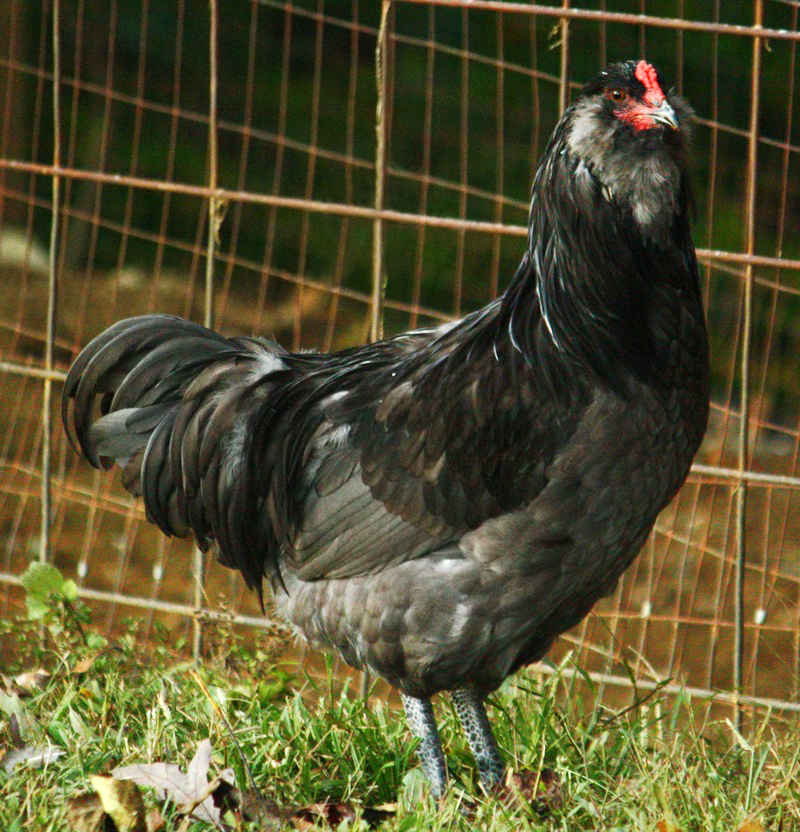
Source Wikipedia
http://en.wikipedia.org/wiki/Ameraucana
What kind of Meat Bird should i purchase?
What kind of Meat Bird should I purchase?
CORNISH ROCK BROILERS – BEST MEAT TYPE
-FAST GROWING
-BROAD BREASTED
-VERY EFFICIENT
- 5-6 POUNDS BUTCHERED WEIGHT IN 7-8 WEEKS
-BUTCHERED WEIGHT WILL BE APPROXIMATEDLY 70% OF THE LIVE WEIGHT
-AVAILABLE WEEKLY JANUARY THRU DECEMBER
-MOST STRAINS HAVE YELLOW SKIN & LEG COLOR, EXCEPT ONE STRAIN HAS WHITE SKIN AND LEG. (HOWEVER, ANYTIME YOU SCALD A CHICKEN WITH YELLOW SKIN TO PICK THE FEATHERS, IT WILL TURN THE SKIN WHITE)
SLOW WHITE BROLER
-VERY SIMILAR TO CORNISH ROCK BROILER EXCEPT IT TAKE 10-14 DAYS LONGER TO GET TO THE SAME WEIGHT. (10-12 WEEKS TO REACH 6-7 LBS LIVE WEIGHT)
-DOES VERY WELL IN HIGHER ELEVATIONS
-DO NOT NEED TO RESTRICT THE FEED
RED RANGER
-12 WEEKS TO MATURE (AVERAGE WEIGHT FOR THE FEMALE 5.74 LBS & THE MALE 7.48 LBS.)
-GOOD FORAGER
-GROWN ADULT MALES CAN REACH UP TO 10 LBS. AND THE FEMALES CAN REACH 8 POUNDS
AND WHITE FEATHERS
RED BROILER
-YELLOW SKIN
-3-4 POUND RANGE IN ABOUT 8 WEEKS
-VARIOUS SHADES OF RED FEATHERS
Storey’s Guide to Raising Poultry, 4th Edition
Storey’s Guide to Raising Poultry, 4th Edition
For decades, animal lovers around the world have been turning to Storey’s guides for the best instruction on everything from hatching chickens to starting and maintaining a full-fledged livestock business. Whether you have been raising animals for a few months or a few decades, the Storey series offers clear, in-depth information on a variety of breeds, latest production methods, and updated health care advice. The 4th edition has been updated for the twenty-first century and contains all the information you will need to raise healthy and content animals.
This revised edition written by Glenn Drowns is in my opinion the only book you need to raise a wide range of poultry from chickens and turkeys to guineas and pheasants. Glenn Drowns, an expert on rare breeds and varieties of turkeys, ducks, and geese delivers everything you need to know to raise healthy, safe poultry in just 464 pages complete with illustrations and a nice glossary.
A diverse flock of poultry can provide free-range meat, eggs, and endless entertainment. Whether you’re running a large farm or raising a few birds in your backyard, Glenn Drowns tells you everything you need to know about health care, breed selection, housing, breeding, incubating, daily feeding, day to day care and the processing meat and eggs.
References:
Storey’s Guide to Raising Poultry
Storey Publications
Submitted by Michelle Coleman
The Chicken Encyclopedia
The Chicken Encyclopedia
This great book written by Gail Damerow is an A-to-Z reference that is both informative and entertaining. Organized alphabetically by term, it covers topics such as anatomy, breeds, coop components, and health problems. Full-color breed illustrations, along with detailed line drawings, such as one depicting how to determine an egg’s age from its position when placed in water, add both visual appeal and substantive information. Tables ease comprehension of complicated subjects like predator identification. It also touches on subjects from addled to wind egg, crossed beak to zygote, the terminology of everything chicken is demystified in this illustrated A-to-Z reference. If it concerns chickens, it’s covered in this comprehensive encyclopedia. You will be sure to find breed descriptions; definitions of common chicken conditions, situations, and behaviors; and much more. Whether it’s the differences among wry tail, split tail, and gamy tail; the meaning of hen feathered, forced molt or quill feather; the content of granite grit; the characteristics of droopy wing; or the translation of a chicken’s alarm call, here are the answers to every chicken question and quandary. This book is a quick reference, but is not meant to be a how-to book, but would go great with Storey’s Guide to Raising Poultry.
From Storey Publishing Co.
Submitted b Michelle Coleman
Fun facts about Wild Turkeys
Male eastern Wild Turkey

- Wild Turkeys were hunted to near extinction in the early 1900’s. Recent numbers now put them around 7 million worldwide.
- There are 6 subspecies of the Wild Turkey found in North America. They are the Eastern, Osceola, Rio Grande, Merriam’s, Gould’s, and South Mexican.
- The Eastern subspecies is the most heavily hunted and most populous at just over 5 million.
- Wild Turkeys have 5000-6000 feathers.
- The record-sized adult male wild turkey, according to the National Wild Turkey Federation, weighed 16.85 kg (37.1 lbs.)
- Benjamin Franklin, in a letter to his daughter in 1784, suggested that the Wild Turkey would be his preference over the Bald Eagle as a symbol of the United States.
- Wild Turkeys are omnivores, and prefers acorns, nuts and various trees such as hazel, chestnut, hickory and pinyon pine. They also like seeds, berries, roots and insects. They occasionally consume amphibians, and lizards and snakes.
- Hens lay a clutch of 10-14 eggs, usually 1 per day. They are incubated 28 days, and after hatching, poults leave the nest after 12-24 hours.
Compiled from
http://en.wikipedia.org/wiki/Wild_turkey


